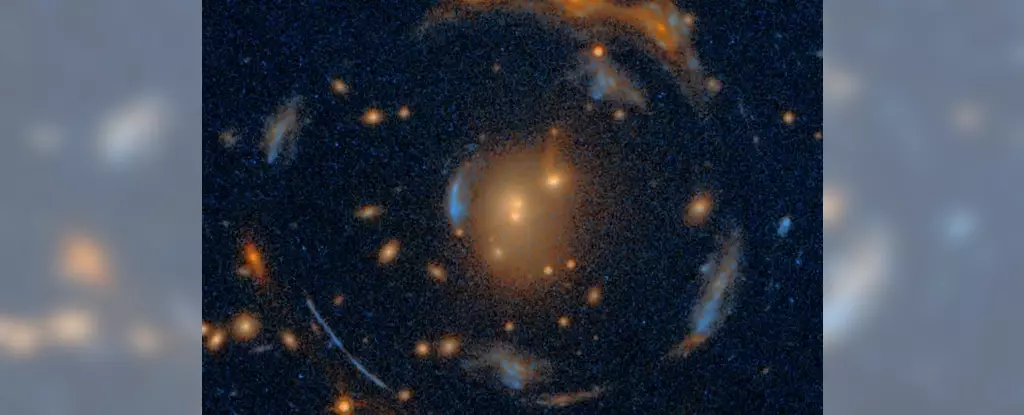Gravitational lensing occurs when a massive object, such as a galaxy cluster, distorts the light from background objects like galaxies or quasars due to its gravitational field. This effect can create multiple images or arcs of the same distant celestial body, behaving like a cosmic magnifying glass. In the grand tapestry of the universe, it serves not only as an artistic optical effect but also as a crucial tool for astronomers. By deciphering the distortions caused by gravitational lensing, researchers can glean substantial insights into the distributions of dark matter, the properties of distant galaxies, and the very fabric of the cosmos itself.
The Carousel Lens: A Cosmic Treasure Trove
Recently, a spectacular instance of gravitational lensing known as the Carousel Lens has captivated astronomers. This phenomenon involves a remarkable alignment of seven distant galaxies, distorted by a foreground galaxy cluster located approximately 5 billion light-years from Earth. Named “The Carousel Lens,” this astronomical wonder presents an extraordinary opportunity to study cosmic relationships across vast distances. According to Berkeley Lab senior scientist David Schlegel, discovering such precise alignments is like finding multiple needles in a haystack—an incredibly rare event indeed.
The unique configuration of the Carousel Lens allows researchers to observe galaxies located between 7.62 to 12 billion light-years away. Each of these distant galaxies showcases elongated and distorted shapes that result from the gravitational effects of the foreground cluster. Notably, one grouping has formed an almost flawless “Einstein Cross,” demonstrating the symmetrical mass distribution associated with gravitational lensing.
The Carousel Lens is a valuable specimen in the study of strong gravitational lenses. Dr. Xiaoshang Huang, a member of the research team investigating this phenomenon, emphasizes its significance in pinpointing critical properties of cosmological interest, including the understanding of dark matter and dark energy, both of which remain some of the universe’s most elusive substances.
The unique configurations exhibited by the Carousel Lens—ranging from arcs to rings—provide a vast array of observational data for scientists. These intricacies offer a golden opportunity to conduct spectral studies to better understand the matter distribution within the lensing cluster itself. As researchers delve deeper into the structure of this cosmic arrangement, the Carousel Lens represents a nexus of inquiry that could unite issues of dark and baryonic matter in an elaborate cosmic dance.
Insights into Distant Galaxies
Among the luminous entities distorted by the Carousel Lens lays an intriguing subject known as Source 7, which exhibits characteristics of a high-redshift quiescent galaxy. This particular structure is not merely an image; it is a window into a formative epoch in cosmic history, potentially revealing details about how galaxies transitioned from vibrant star-forming regions to more subdued, quiescent states. Such transitions raise captivating questions about the interplay between intricate forces in the universe, including supermassive black holes, galaxy mergers, and the dynamic feedback loops that may govern cosmic evolution.
The exploration of Source 7 offers astronomers a chance to investigate “early galaxy quenching”—a phenomenon where star formation ceases, transforming an active galaxy into a dormant one. The mechanisms behind quenching are numerous, yet the most often cited scenario involves interactions with a central supermassive black hole during periods of galactic merger, a prevalent event in the crowded landscapes of early universe history.
As scholars continue to compute the properties of the Carousel Lens and its surrounding structures, its implications for the understanding of the universe expand exponentially. This gravitational lens not only aids in reconstructing the cosmic landscape but also informs current theories about the formation and evolution of galaxies through time. The potential for further research suggests that we will continue to enhance our knowledge of the dynamics at play in these distant regions of space.
The Carousel Lens stands as a beacon within the vast complexity of the universe, revealing diverse cosmological phenomena through careful study. It amalgamates art, science, and intrigue, inviting both astrophysicists and enthusiasts alike to ponder the tantalizing mysteries suspended in the cosmos beyond our reach. As researchers refine their understandings and models, the Carousel Lens will undoubtedly remain an exceptional subject in the ongoing quest to unravel the universe’s most profound enigmas.


Leave a Reply